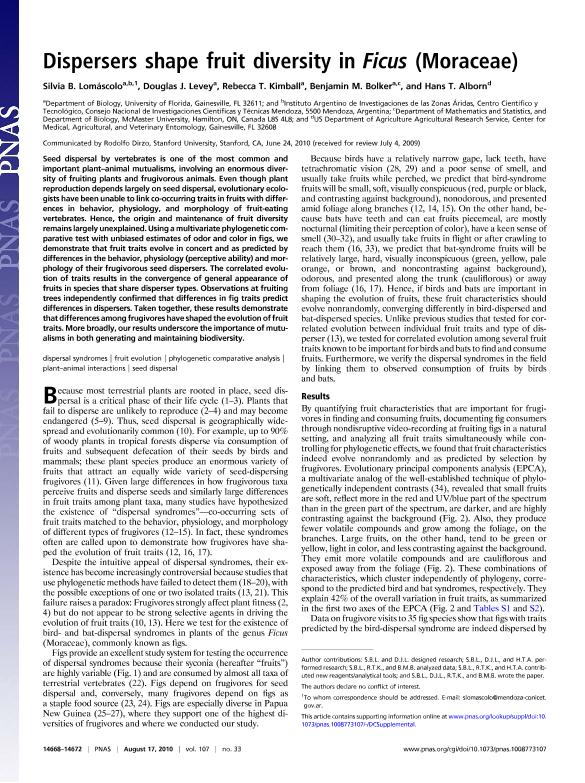Mostrar el registro sencillo del ítem
dc.contributor.author
Lomascolo, Silvia Beatriz

dc.contributor.author
Levey, Douglas J.
dc.contributor.author
Kimball, Rebecca T.
dc.contributor.author
Bolker, Benjamin M.
dc.contributor.author
Alborn, Hans T.
dc.date.available
2019-04-08T22:17:21Z
dc.date.issued
2010-08
dc.identifier.citation
Lomascolo, Silvia Beatriz; Levey, Douglas J.; Kimball, Rebecca T.; Bolker, Benjamin M.; Alborn, Hans T.; Dispersers shape fruit diversity in Ficus (Moraceae); National Academy of Sciences; Proceedings of the National Academy of Sciences of The United States of America; 107; 33; 8-2010; 14668-14672
dc.identifier.issn
0027-8424
dc.identifier.uri
http://hdl.handle.net/11336/73527
dc.description.abstract
Seed dispersal by vertebrates is one of the most common and important plant-animal mutualisms, involving an enormous diversity of fruiting plants and frugivorous animals. Even though plant reproduction depends largely on seed dispersal, evolutionary ecologists have been unable to link co-occurring traits in fruits with differences in behavior, physiology, and morphology of fruit-eating vertebrates. Hence, the origin and maintenance of fruit diversity remains largely unexplained.Using amultivariate phylogenetic comparative test with unbiased estimates of odor and color in figs, we demonstrate that fruit traits evolve in concert and as predicted by differences in the behavior, physiology (perceptive ability) and morphology of their frugivorous seed dispersers. The correlated evolution of traits results in the convergence of general appearance of fruits in species that share disperser types. Observations at fruiting trees independently confirmed that differences in fig traits predict differences in dispersers. Taken together, these results demonstrate that differencesamong frugivores have shaped the evolution of fruit traits. More broadly, our results underscore the importance of mutualisms in both generating and maintaining biodiversity.
dc.format
application/pdf
dc.language.iso
eng
dc.publisher
National Academy of Sciences

dc.rights
info:eu-repo/semantics/openAccess
dc.rights.uri
https://creativecommons.org/licenses/by-nc-sa/2.5/ar/
dc.subject
Dispersal Syndromes
dc.subject
Fruit Evolution
dc.subject
Phylogenetic Comparative Analysis
dc.subject
Plant-Animal Interactions
dc.subject
Seed Dispersal
dc.subject.classification
Otras Ciencias Biológicas

dc.subject.classification
Ciencias Biológicas

dc.subject.classification
CIENCIAS NATURALES Y EXACTAS

dc.title
Dispersers shape fruit diversity in Ficus (Moraceae)
dc.type
info:eu-repo/semantics/article
dc.type
info:ar-repo/semantics/artículo
dc.type
info:eu-repo/semantics/publishedVersion
dc.date.updated
2019-04-03T15:00:44Z
dc.identifier.eissn
1091-6490
dc.journal.volume
107
dc.journal.number
33
dc.journal.pagination
14668-14672
dc.journal.pais
Estados Unidos

dc.journal.ciudad
Washington DC
dc.description.fil
Fil: Lomascolo, Silvia Beatriz. Consejo Nacional de Investigaciones Científicas y Técnicas. Centro Científico Tecnológico Conicet - Mendoza. Instituto Argentino de Investigaciones de las Zonas Áridas. Provincia de Mendoza. Instituto Argentino de Investigaciones de las Zonas Áridas. Universidad Nacional de Cuyo. Instituto Argentino de Investigaciones de las Zonas Áridas; Argentina. University of Florida; Estados Unidos
dc.description.fil
Fil: Levey, Douglas J.. University of Florida; Estados Unidos
dc.description.fil
Fil: Kimball, Rebecca T.. University of Florida; Estados Unidos
dc.description.fil
Fil: Bolker, Benjamin M.. University of Florida; Estados Unidos. McMaster University; Canadá
dc.description.fil
Fil: Alborn, Hans T.. United States Department of Agriculture. Agriculture Research Service; Estados Unidos
dc.journal.title
Proceedings of the National Academy of Sciences of The United States of America

dc.relation.alternativeid
info:eu-repo/semantics/altIdentifier/url/www.pnas.org/cgi/doi/10.1073/pnas.1008773107
dc.relation.alternativeid
info:eu-repo/semantics/altIdentifier/doi/https://doi.org/10.1073/pnas.1008773107
Archivos asociados
